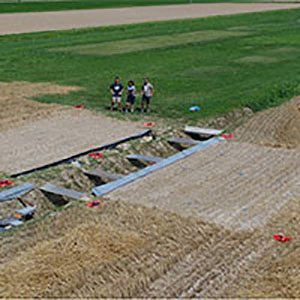Multi-temporal geomorphometric analysis to assess soil erosion under different tillage practices: A methodological case study

Published:31 March 2022
Abstract Views: 1123
PDF: 492
Appendix: 119
HTML: 47
Appendix: 119
HTML: 47
Publisher's note
All claims expressed in this article are solely those of the authors and do not necessarily represent those of their affiliated organizations, or those of the publisher, the editors and the reviewers. Any product that may be evaluated in this article or claim that may be made by its manufacturer is not guaranteed or endorsed by the publisher.
All claims expressed in this article are solely those of the authors and do not necessarily represent those of their affiliated organizations, or those of the publisher, the editors and the reviewers. Any product that may be evaluated in this article or claim that may be made by its manufacturer is not guaranteed or endorsed by the publisher.
Similar Articles
- Vincenzo Bagarello, Vito Ferro, Dennis Flanagan, Predicting plot soil loss by empirical and process-oriented approaches. A review , Journal of Agricultural Engineering: Vol. 49 No. 1 (2018)
- Hossein Khaledian, Homayoun Faghih, Ata Amini, Classifications of runoff and sediment data to improve the rating curve method , Journal of Agricultural Engineering: Vol. 48 No. 3 (2017)
- Ossama M. M. Abdelwahab, Ronald L. Bingner, Fabio Milillo, Francesco Gentile, Effectiveness of alternative management scenarios on the sediment load in a Mediterranean agricultural watershed , Journal of Agricultural Engineering: Vol. 45 No. 3 (2014)
- Tommaso Baggio, Francesco Bettella, Lucia Bortolini, Vincenzo d'Agostino, Hydrologic performance assessment of nature-based solutions: a case study in North-eastern Italy , Journal of Agricultural Engineering: Vol. 54 No. 2 (2023)
- Azam Rezaei, Hassan Masoudi, Hassan Zaki Dizaji, Mohamad Esmail Khorasani Ferdavani, Modelling, analysis, and optimisation of the rear axle of cereal combine harvester under real loads using finite elements method , Journal of Agricultural Engineering: Vol. 54 No. 2 (2023)
- Lorenzo Picco, Luca Mao, Emanuel Rigon, Johnny Moretto, Diego Ravazzolo, Fabio Delai, Mario Aristide Lenzi, An update of the sediment fluxes investigation in the Rio Cordon (Italy) after 25 years of monitoring , Journal of Agricultural Engineering: Vol. 43 No. 3 (2012)
- Johnny Moretto, Emanuel Rigon, Luca Mao, Lorenzo Picco, Fabio Delai, Mario Aristide Lenzi, Medium- and short-term channel and island evolution in a disturbed gravel bed river (Brenta River, Italy) , Journal of Agricultural Engineering: Vol. 43 No. 4 (2012)
- Nathalie Almaru Caraballo-Arias, Vito Ferro, Assessing, measuring and modelling erosion in calanchi areas: a review , Journal of Agricultural Engineering: Vol. 47 No. 4 (2016)
- Dina Statuto, Giuseppe Cillis, Pietro Picuno, Analysis of the effects of agricultural land use change on rural environment and landscape through historical cartography and GIS tools , Journal of Agricultural Engineering: Vol. 47 No. 1 (2016)
- Andrea De Montis, Amedeo Ganciu, Fabio Recanatesi, Antonio Ledda, Vittorio Serra, Mario Barra, Stefano De Montis, The scientific production of Italian agricultural engineers: a bibliometric network analysis concerning the scientific sector AGR/10 Rural buildings and agro-forestry territory , Journal of Agricultural Engineering: Vol. 48 No. s1 (2017): Special Issue
You may also start an advanced similarity search for this article.

 https://doi.org/10.4081/jae.2022.1279
https://doi.org/10.4081/jae.2022.1279 











